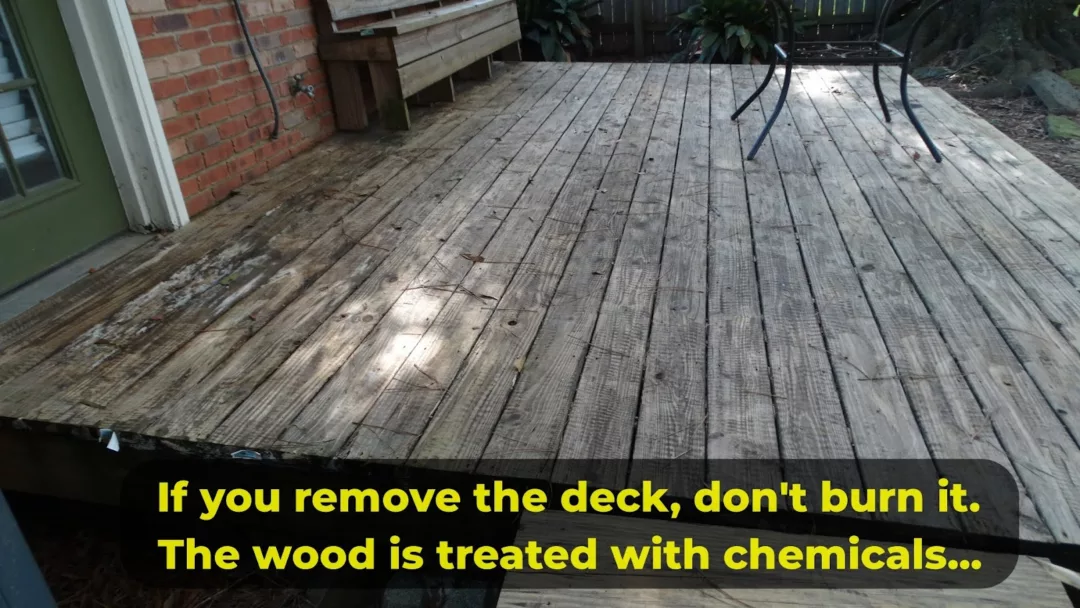Estimated reading time: 5 minutes
Several factors, including climate zone, maintenance practices, material type, and usage, can influence the life cycle of exposed wood decks. So, when I make this statement: “The methods of construction on this deck are substandard and no longer permitted, and repair is possible, but replacement would be more feasible given the age and deterioration of the material.”, it means I’m concerned for your safety, and you should consider the consequences.
Here are a few factors in more detail:
Climate Zone: The climate in which a wood deck is located plays a significant role in its life cycle. Different climate zones experience varying levels of temperature, humidity, rainfall, and exposure to sunlight. For instance, decks in regions with high humidity and frequent rainstorms are more prone to moisture damage, rot, and mold growth. In contrast, decks in arid climates might face challenges such as excessive heat and dryness, leading to cracking and splitting of the wood. Understanding the specific climate conditions is crucial in selecting the appropriate materials and maintenance practices to ensure the deck’s longevity.
Maintenance: Regular maintenance is essential for preserving the life of an exposed wood deck. Factors such as cleaning, sealing, staining, and repairs significantly impact its durability. Neglecting maintenance can result in accelerated wear and tear, increased vulnerability to moisture damage, and the growth of mold and mildew. Routine inspections and timely maintenance practices, such as cleaning debris, resealing the wood, and addressing any structural issues, can significantly extend the life of a deck.
Material Type: The choice of wood material used for deck construction affects its longevity. Different wood species have varying resistance levels to weathering, decay, and insect infestations. Common wood options for decks include pressure-treated lumber, cedar, redwood, and tropical hardwoods like ipe. Pressure-treated lumber is popular due to its resistance to rot and insects, while cedar and redwood naturally resist decay. Tropical hardwoods are known for their exceptional durability but may require more maintenance. Additionally, the quality of the wood, such as its grade and moisture content, also influences the deck’s life cycle.
Usage: A wood deck’s usage patterns and activities impact its wear and tear. Foot traffic, furniture placement, and exposure to heavy loads or impact can affect the deck’s structural integrity. Decks used for frequent entertaining, hosting large gatherings, or accommodating heavy objects may require additional reinforcement and maintenance to withstand the increased stress. Similarly, decks with high foot traffic should be built with durable materials and inspected regularly to identify and address any signs of deterioration.
While the factors listed above are crucial in determining the life cycle of exposed wood decks, it’s important to note that proper design, construction techniques, and adherence to local building codes (if any) also contribute to their longevity. Seeking professional advice and following best practices in deck construction, maintenance, and usage guidelines can help maximize the lifespan of a wood deck.

If your deck is a tear-down, take care and don’t burn chemical-treated wood. The smoke and fumes may be caustic and dangerous to inhale.
Design and Construction: The design and construction of the deck can impact its durability and longevity. Proper structural support, appropriate fasteners and connectors, and correct installation techniques are essential to ensure the deck can withstand the anticipated loads and environmental conditions. The deck’s layout, including the size, shape, and configuration, should be designed with factors such as drainage, ventilation, and access in mind to minimize potential issues.
Exposure to Moisture: Exposure to moisture is one of the primary factors that can affect the life cycle of a wood deck. Moisture from rain, snow, or irrigation systems can penetrate the wood, leading to swelling, warping, and rotting. Adequate measures should be taken to minimize moisture contact, such as installing proper drainage systems, maintaining gaps between deck boards for water runoff, and using appropriate sealants or coatings to protect the wood.
Sun Exposure: Excessive exposure to sunlight can cause wood decks to fade, dry out, and become more susceptible to cracking and splitting. UV rays from the sun can break down the lignin in wood, leading to surface degradation. Choosing wood species or finishes that provide UV protection can help mitigate sun damage and extend the deck’s lifespan.
Environmental Factors: Factors such as proximity to saltwater, coastal areas, or areas with high pollution levels can impact the life cycle of a wood deck. Saltwater can accelerate the corrosion of metal components and fasteners and increase the risk of decay. High levels of air pollution can cause staining and surface damage. In such environments, selecting appropriate materials and implementing regular cleaning and maintenance routines become even more crucial.
Pest Infestation: Wood decks are susceptible to insect infestations, such as termites, carpenter ants, or wood-boring beetles. These pests can cause significant damage to the structural integrity of the deck. Preventive measures like using pressure-treated lumber, periodic inspections, and promptly addressing any signs of pest activity can help mitigate infestation risk.
Quality of Installation: I’ve saved the best one for last. The quality of installation, including the skill and expertise of the builder, adherence to building codes, and use of proper construction techniques, can greatly impact the longevity of a wood deck. In other words, a carpenter’s methods of building the deck can lead to structural issues, poor load distribution, and increased susceptibility to damage over time. As a retired woodworker, I don’t like to “call out” the quality of another carpenter; however, the quality of deck construction matters, and poor quality can lead to dangerous conditions that put you at risk.
Considering these factors should provide you with a more comprehensive understanding of the potential challenges and considerations for the life cycle of an exposed wood deck.
Take care, and have your deck inspected regularly.
- - - - - - - - - - - - - - - - - - - - -